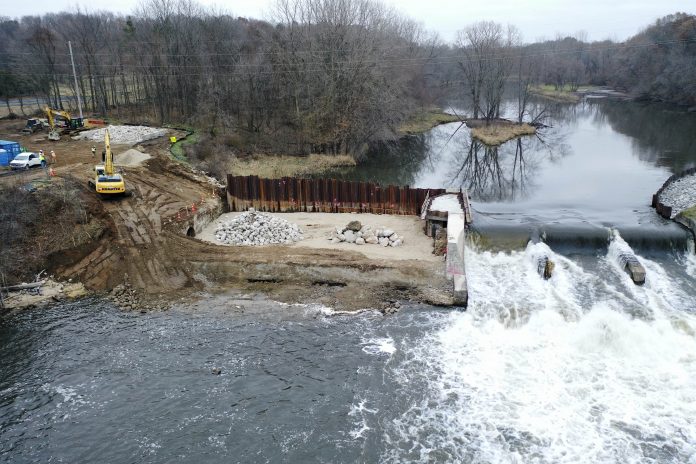
One of the companies responsible for polluting an 80-mile (129-kilometer) stretch of river and floodplains in southwestern Michigan with toxic chemicals will pay at least $245.2 million to advance a cleanup effort that began more than 20 years ago, federal officials said Wednesday.
NCR Corp. will fund the dredging of contaminated sediments and removal of an aging dam in the Kalamazoo River under an agreement with the U.S. Environmental Protection Agency, the U.S. Department of Justice and the state of Michigan, officials told The Associated Press ahead of an official announcement.
“This is a big step forward toward cleaning up the river,” said John Irving, a deputy assistant administrator in the EPA’s Office of Enforcement and Compliance Assurance.
The Kalamazoo is polluted with polychlorinated biphenyls, or PCBs, from paper recycling mills. Used for ink removal, the chemicals were discharged into the river from the 1950s through the mid-1970s. They also seeped into groundwater and surface waters from landfills where mill waste was dumped.
In addition to the river, the contamination zone in Allegan and Kalamazoo counties includes a roughly 3-mile (5-kilometer) section of a tributary called Portage Creek, as well as mill properties, riverbanks and floodplains. It is on the federal Superfund list of hazardous sites.
Signs posted along the river warn anglers not to eat the fish they catch.
The EPA has overseen the removal of nearly 450,000 cubic yards (344,000 cubic meters) of soil and sediment from the area since 1998, in addition to cleaning up 7 miles (11 kilometers) of the river and riverbanks. Eighty-two acres (33 hectares) of landfills containing PCBs have been covered with layers of clay, topsoil and vegetation to prevent the toxins from leaching into groundwater.
But much remains to be done. The agreement between NCR and the government calls for the company to pay at least $135.7 million for cleanup work that is expected to take an additional 10-15 years.
Among the tasks: dismantling Trowbridge Dam in Allegan County.
The dam, which was built in 1898 to supply electric power to Kalamazoo, is in poor shape and has been over-topped by high water. It is the highest-priority dam removal planned in Michigan, according to the state Department of Natural Resources, which set aside $2.9 million in May to get the project underway.
The first step is to stabilize the structure so that it won’t collapse while a contractor dredges PCB-laced sediments from a 2.4-mile (3.9-kilometer) river section upstream, which is expected to take three years, said Paul Ruesch, the EPA’s on-site coordinator.
NCR funds will pay for that work and for razing the dam when the sediment removal is complete, Assistant U.S. Attorney General Jeffrey Bossert Clark told the AP.
“You want to get that sediment out before taking the dam out, so you’re not letting the sediments wash further downstream,” he said.
The removal of tainted soils in several floodplain spots is also funded under the deal. And the company will also pay $76.5 million to the EPA to cover past and future costs of the river cleanup; $27 million to other federal and state agencies for damages to natural resources; and $6 million to the state for past and future costs.
The proposed settlement was filed in federal court Wednesday. The public will get 30 days to comment, after which the government agencies could make revisions before requesting final court approval.
NCR spokesman Scott Sykes said the company had no comment.
The agreement represents a significant milestone in the overall cleanup, which is expected to end up costing about $851 million, Clark said. Payment negotiations are continuing with other companies that share responsibility for the pollution, including Georgia-Pacific, International Paper and Weyerhaeuser.
The Kalamazoo River project is among those on the Superfund list designated by the Trump administration for special attention because of cleanup delays, Irving said.
“This settlement represents substantial progress in the cleanup and restoration of the Kalamazoo River,” said Liesl Clark, Director of the Michigan Department of Environment, Great Lakes and Energy. In addition to protecting public health and the environment, she said, it will fund “projects to restore natural resources and help compensate the public for lost recreational opportunities within this important Southwest Michigan watershed.”q
___



















